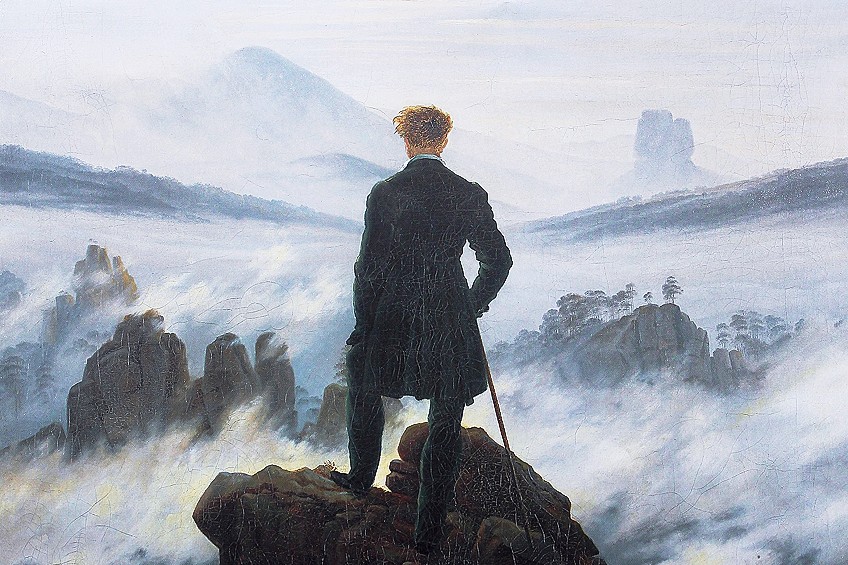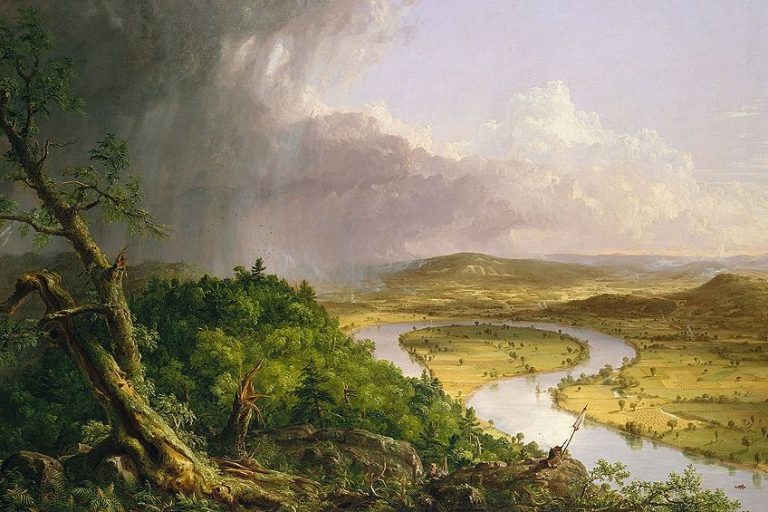“Wanderer Above the Sea of Fog” by Caspar David Friedrich
Wanderer Above the Sea of Fog (c. 1818) by Caspar David Friedrich has become an iconic painting depicting the depths of solitude. It is one of the finest examples from the German Romantic art movement and the one that we will discuss in more detail in this article.
Artist Abstract: Who Was Caspar David Friedrich?
Caspar David Friedrich was born on 5 September 1774 and died on 7 May 1840, in Germany in the town of Greifswald. In his early years, he studied under Johann Gottfried Quistorp at the University of Greifswald and was introduced to various other notable artists and ideas around nature and God.

He attended the Copenhagen Academy from 1794 to 1798, after which he relocated to Dresden. He became popular for his landscape paintings that were deeply rooted in aspects of the sublime and spiritual. In Friedrich’s personal life, he experienced numerous deaths of family and friends, and he was remembered as a solitary person.
His artworks influenced many other art styles like Surrealism, Symbolism, and Abstract Expressionism. He was also admired by Adolf Hitler.
Wanderer Above the Sea of Fog (c. 1818) by Caspar David Friedrich in Context
Below we will provide a brief contextual analysis exploring the Wanderer Above the Sea of Fog meaning. In German this painting is titled Der Wanderer Über Dem Nebelmeer. We will then provide a formal analysis, discussing the subject matter and Friedrich’s artistic approaches in terms of the art elements like color, texture, line, form, and space, which all set the tone for an ambient and deeply moving subject.
| Artist | Caspar David Friedrich |
| Date Painted | c. 1818 |
| Medium | Oil on canvas |
| Genre | Symbolism, Landscapes |
| Period / Movement | Romanticism, German Romanticism |
| Dimensions | 98.4 x 74.8 centimeters |
| Series / Versions | N/A |
| Where Is It Housed? | Hamburger Kunsthalle, Hamburg, Germany |
| What It Is Worth | Price is uncertain |
Contextual Analysis: A Brief Socio-Historical Overview
Wanderer Above the Sea of Fog by Caspar David Friedrich was painted during the early 1800s, at a time in Europe when Romanticism was a prevailing style in arts and culture, ranging from literature, visual arts, and music. It was believed that the earlier Sturm und Drang movement was a precursor to the Romantic movement.
Sturm und Drang was a German movement, meaning “Storm and Stress”, active during the latter half of the 1700s. The importance of this movement was the emphasis on emotion and self-expression, and it is commonly described as “subjective”.
It was most prevalent in music and literature and received its name from the Sturm und Drang (1777) play by Friedrich Maximillian Klinger. Additionally, the German writer Johann Wolfgang von Goethe was a leading proponent of the movement and became widely known for his publication The Sorrows of Young Werther (1774).

This novel greatly influenced Romanticism, which developed afterward. Romanticism was also categorized as more emotive and subjective and moved away from the intellectualism that came from preceding movements like Neoclassicism during the mid-1700s.
It is important to note that Romanticism developed across European countries like France, Germany, England, and Spain. For the purposes of our article, we will focus on German Romanticism, providing a context for Caspar David Friedrich’s artworks.
In the spirit of freedom, German Romanticism sought self-expression that celebrated the majesty of nature, and landscape art became a conduit for this expression. Furthermore, it was not solely the depiction of nature, but the deep bond between man and nature, veering on the subliminal.
The Man and His Outfit: Wanderer Above the Sea of Fog Meaning
The question, “When was Wanderer Above the Sea of Fog made?” is an important one to explore, as we have done briefly above. However, its date points to pertinent periods in history that influenced its meaning, such as the Napoleonic Wars, the impacts of the French insurgency in Germany, and the socio-political aspects that ensued as a result of these.
The figure in “Der Wanderer Über Dem Nebelmeer”, according to some art history sources, could have been Caspar David Friedrich himself, based on the red hair color.
Other scholars, like Joseph Koerner, believe the man could have been Colonel Friedrich Gotthard von Brincken and that this painting was a sort of “patriotic epitaph” created for him after his death. This touches on Friedrich’s preoccupation with the political climate during the early 19th-century, and that he was a German Nationalist, hinted at by the figure’s outfit, which is reminiscent of what is referred to as Altdeutsche Tracht, meaning “’ Old German costume”.
These outfits were commonly worn by Germans during this period as statements against the Napoleonic Wars, which were prevalent in Europe from 1799 to around 1815. This costume, in short, symbolized a sense of nationalism against the invading French.
Formal Analysis: A Brief Compositional Overview
Below we will discuss a formal analysis of Wanderer Above the Sea of Fog by Caspar David Friedrich, first describing the painting and its subject matter and then the artist’s style in terms of several art elements like color, texture, line, form, and space, among others, and how they impact and determine the overall artistic unity of the composition.
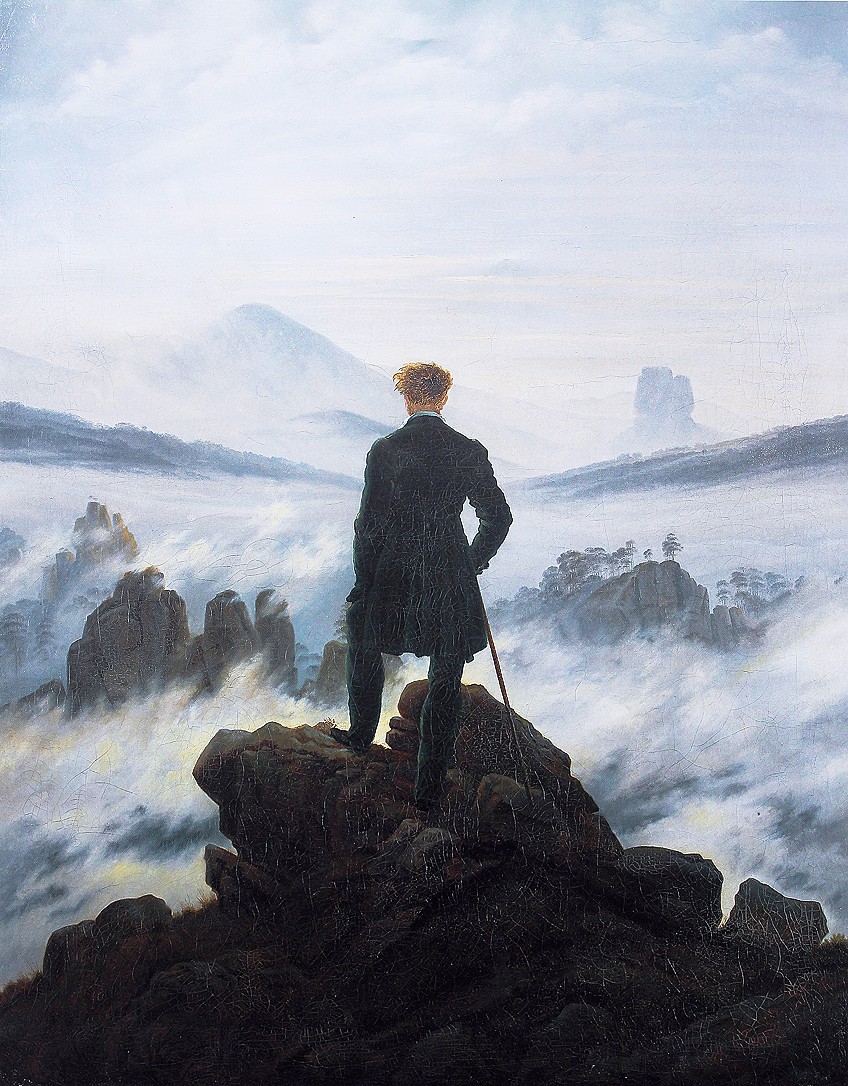
Visual Description: Subject Matter
In the first third and foreground of the painting Wanderer Above the Sea of Fog, we see a solitary figure standing on the edge of a protruding rock formation. He looks out over a vast, foggy, landscape of what appears to be a mountainous region in the far distance, in the background of the composition.
An interesting fact about this landscape is that Friedrich reportedly depicted the Elbe Sandstone Mountain region. This mountain range is between Saxony in Germany and Bohemia in the Czech Republic.
Furthermore, Friedrich apparently made sketches of the mountain ranges while he was there in person and repainted certain ranges from his visual documentation. Therefore, it is possibly not the exact depiction of the mountain ranges and their placements. The man stands with his back to us, the viewers, which is a common technique, otherwise referred to as “compositional strategy/device”, that Caspar David Friedrich utilized to depict his figures.
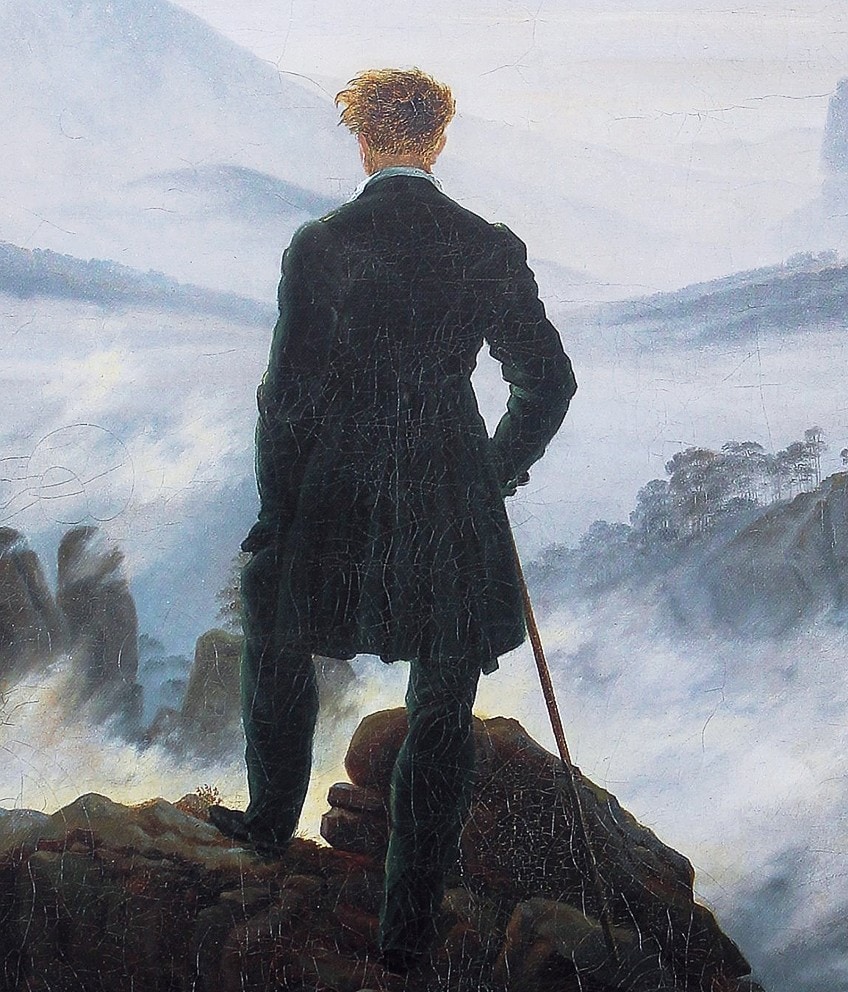
This technique is known as Rückenfigur, which is the German word for “figure from the back”. It is also evident in some of Friedrich’s other paintings, for example, The Monk by the Sea (1808 – 1810), Two Men by the Sea (1817), and Woman at a Window (1822).
In the middle-ground, there are more rocky ridges protruding through their misty veil, right in front of this lonely wanderer. Some of the rocky tops also have trees on them and we can notice what appears to be a canopy of trees also peeping through the misty veil.
The upper third of the composition is composed of the sky above, filled with white clouds that seemingly become part of the mist that covers the mountains in the distance, blanketing the rest of the scenery in the foreground. There is almost a sense of motion and aliveness here as the mist moves inwards and outwards.

If we look at the man, he is wearing an overcoat that has been described as dark green in color. His red hair is short and appears windblown. He is holding a walking stick in his right hand and his left hand seems to be resting on the upper part of his left leg, which is slightly bent and propped up on the rocky promontory, stabilizing his posture as he stands; his right leg is straight.
Color, Value, and Light
If we look at artistic elements like color and value, Friedrich utilized whites, pinks, and blues for the sky above and darker colors for the rocks in the foreground as well as dark green for the man’s coat. The painting’s value consists of a notable contrast between light and dark in this composition.

The foreground is dark, and the background is light. Value is an art element that refers to how light or dark a color appears and is often demonstrated on a grayscale. It also adds highlights to an image, which gives it more color harmony.
In “Wanderer Above the Sea of Fog”, we see there is a darker area of color in the foreground, we can say about a third of the composition, and the background, or two-thirds of the rest of the composition, appears lighter.
Furthermore, there is an implied, natural, light source from the sun, although we cannot directly see it because of the mist and clouds. The man is facing this light, which creates a contrasting effect from the way the light falls.
Texture
Wanderer Above the Sea of Fog is filled with a texture that sets this landscape scene. The best examples include the way Friedrich painted the mist and clouds, which appear like white wisps throughout the upper two-thirds of the composition.
There is an implied texture of lightness, air, and fleetingness here, furthermore, creating a rhythm and movement to the scene.

Additionally, Friedrich also created an implied texture in all the rocky regions, for example, the rocks in the foreground on which the man stands. These have a rougher and craggy texture compared to the mist and fog, which creates another contrasting effect.
Line, Form, and Shape
There is a focus on vertical lines in this composition, notably the figure standing upright and looking out over the horizon. This is a clear shape in our view compared to the other shapes in the distance formed by the fog and mountains.
These shapes are less distinct and appear hazier, further highlighting the man in the foreground.
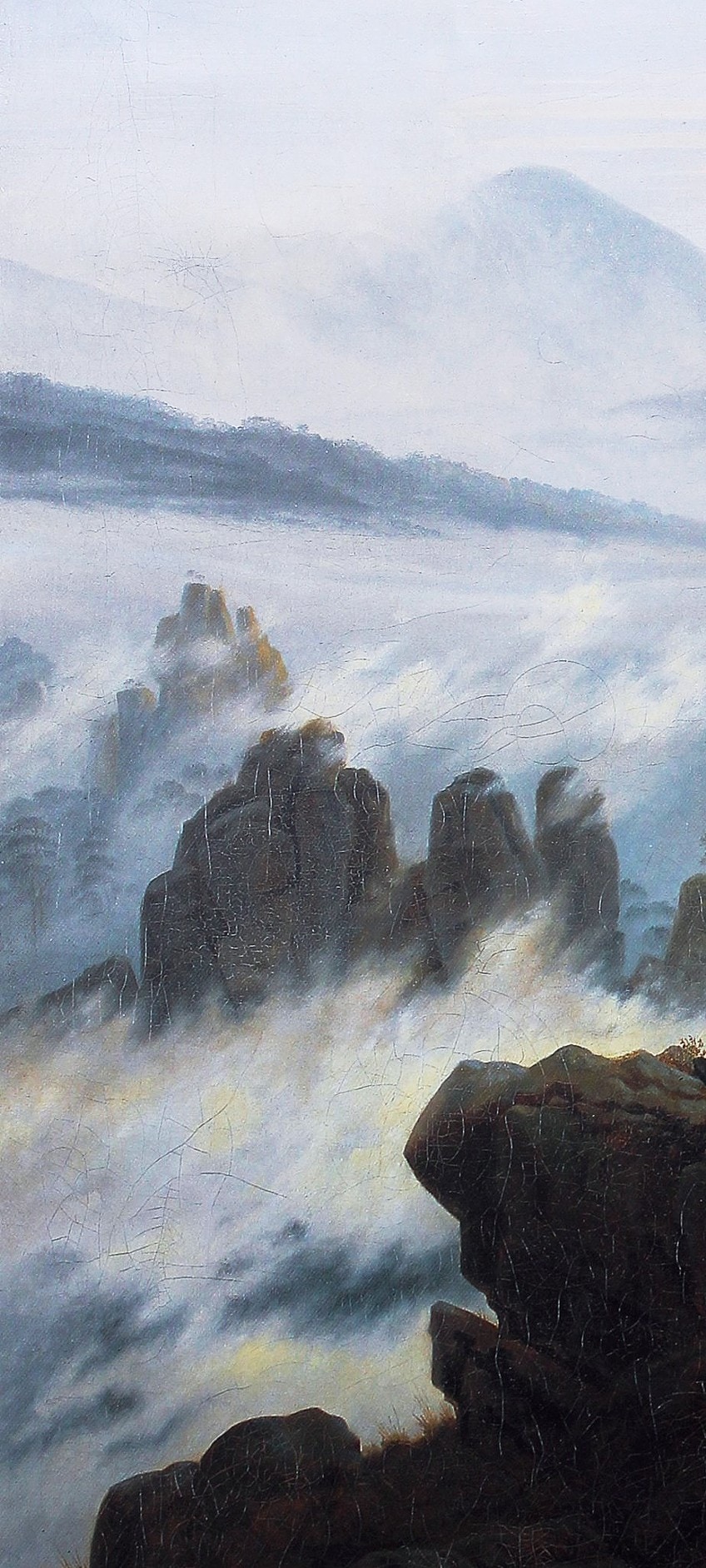
In the middle ground, there are two horizontal lines created by the surrounding mist and hillside landscape. These appear to converge in the center, almost creating a focal point in the distance and seemingly bringing our focus onto the man in the foreground.
Space
Space is an important aspect of this composition. Friedrich depicted a vast landscape, achieved through highlighting, contrasting, and converging colors, textures, and various lines and shapes. These all create the illusion of three-dimensional landscape space, or depth, we see in front of us.
This depth is further created by what is known as “atmospheric perspective”, which is the hazy effect of the landscape in the distance, as well as the scale implied by the figure in the foreground compared to the background.

Space as an art element also includes positive and negative space. Positive space is created by the subject of the composition, and here it would be the figure and the rocky areas in the foreground. Negative space includes the space around the primary subject, which would be the mist and clouds.
In the Presence and Precipice of Greatness
The Wanderer Above the Sea of Fog is over 200 years old, still impacting modern-day viewers, reminding us of age-old truths that seemingly go beyond being human. Even in our contemporary times, this painting has made its way into popular culture, inspiring film posters, adorning book covers, and becoming a popular motif on items like T-shirts.
Friedrich’s artworks even became tokens of appreciation and propaganda for the German Adolf Hitler. This association marred Friedrich’s reputation as an artist, however, his reputation was eventually restored within the art world.
“Wanderer Above the Sea of Fog” by Caspar David Friedrich depicts a man face-to-face with the vastness of nature, and ultimately, God. He is truly in the presence of greatness, and as we look at him looking at the landscape, even possibly contemplating his life and nature, we are similarly face-to-face with this landscape, contemplating our own place in this magnitude. We too, stand on the precipice of greatness.
Take a look at our Wanderer Above the Sea of Fog webstory here!
Frequently Asked Questions
Who Painted Wanderer Above the Sea of Fog?
The Wanderer Above the Sea of Fog (c. 1818), also titled Der Wanderer Über Dem Nebelmeer, was painted by the German artist Caspar David Friedrich. It became one of the most popular German Romanticism paintings.
When Was Wanderer Above the Sea of Fog Made?
Wanderer Above the Sea of Fog by Caspar David Friedrich is dated 1818, which was during European art history when art styles shifted from Neoclassicism to Romanticism. This painting, also called Der Wanderer Über Dem Nebelmeer, has been categorized as German Romanticism.
Where Is Wanderer Above the Sea of Fog?
The Wanderer Above the Sea of Fog (c. 1818) is housed at the Kunsthalle art gallery in Hamburg, Germany. It was received by the gallery and made part of the collection around 1970.
Alicia du Plessis is a multidisciplinary writer. She completed her Bachelor of Arts degree, majoring in Art History and Classical Civilization, as well as two Honors, namely, in Art History and Education and Development, at the University of KwaZulu-Natal, South Africa. For her main Honors project in Art History, she explored perceptions of the San Bushmen’s identity and the concept of the “Other”. She has also looked at the use of photography in art and how it has been used to portray people’s lives.
Alicia’s other areas of interest in Art History include the process of writing about Art History and how to analyze paintings. Some of her favorite art movements include Impressionism and German Expressionism. She is yet to complete her Masters in Art History (she would like to do this abroad in Europe) having given it some time to first develop more professional experience with the interest to one day lecture it too.
Alicia has been working for artincontext.com since 2021 as an author and art history expert. She has specialized in painting analysis and is covering most of our painting analysis.
Learn more about Alicia du Plessis and the Art in Context Team.
Cite this Article
Alicia, du Plessis, ““Wanderer Above the Sea of Fog” by Caspar David Friedrich.” Art in Context. May 22, 2022. URL: https://artincontext.org/wanderer-above-the-sea-of-fog-by-caspar-david-friedrich/
du Plessis, A. (2022, 22 May). “Wanderer Above the Sea of Fog” by Caspar David Friedrich. Art in Context. https://artincontext.org/wanderer-above-the-sea-of-fog-by-caspar-david-friedrich/
du Plessis, Alicia. ““Wanderer Above the Sea of Fog” by Caspar David Friedrich.” Art in Context, May 22, 2022. https://artincontext.org/wanderer-above-the-sea-of-fog-by-caspar-david-friedrich/.


